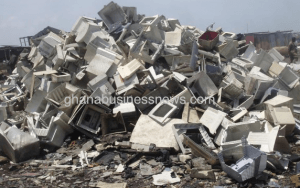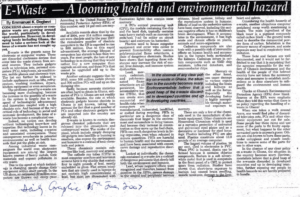Ghana Parliament finally passes E-waste Law

Nine years after the first journalistic work on e-waste dumping in Ghana was published in the Daily Graphic June 2007, the Parliament of Ghana has passed the law to regulate e-waste this week. It is now awaiting presidential assent.
The Hazardous and Electronic Waste Control Management Bill 2016 was drafted in 2012 and after some delays due to periodic ministerial reshuffles; it was presented to parliament.
Among its provisions, the E-waste Law would require manufacturers and importers of electronics, excluding state agencies, to register with the EPA and to pay levies that would go into a fund for the collection, treatment, recovery and environmentally-sound disposal of electronic waste.
Alongside fines and other revenue mobilization, the fund would also go into construction and maintenance of e-waste treatment plants, research and public education.
The Law says that the fund should be managed entirely by the public sector; a seven-member board of trustees from the public sector – state Ministries, Departments and Agencies including the Controller and Accountant General’s Department, the EPA, MESTI and others.
While Ghana has been cited as a major e-waste destination for Europe, the level of dumping and the classification of the Agbogloshie site as the most polluted are in dispute.

The only scientifically produced report on e-waste in Ghana published in 2011 found that 171,000 tons of e-waste reaches the country’s informal recycling sector, adding that the amount of material that reaches the formal recycling sector accounted only for 0.2 per cent.
The report on Ghana, by Green Ad, a Ghanaian NGO, the Environmental Protection Agency (EPA) of Ghana and the Swiss Federal Laboratories for Materials Testing and Research (EMPA) notes that, “there are a number of laws and regulations that have some relevance to the control and management of hazardous wastes, including e-waste, “but they do not address the dangers posed to humans and the environment from such wastes.”
Meanwhile, the environmental and health risks posed by the cancer causing agents in electronics waste or e-waste are getting closer to many Ghanaians living in and around the e-waste processing centre in Agbogbloshie in Accra.
Multiple scientific studies done on soil and water collected from the sites are showing extremely higher levels of carcinogenic substances such as lead, cadmium, barium and others, and these are spreading beyond the processing site. The contamination has reached areas including James Town, Korle-Gonno and the Korle-Bu Teaching Hospital.
E-waste is the generic name for electronic or computer wastes. These are discarded electronics devices that come into the waste stream from several sources.
They include gadgets like televisions, personal computers (PCs), telephones, air conditioners, cell phones, and electronic toys.
The list can further be widened to include appliances such as lifts, refrigerators, washing machines, dryers, kitchen equipment or even aeroplanes.
The problems posed by e-waste are becoming more challenging, because the increase in the quantity of e-waste in the system is largely due to the speed of technological advancement and innovation coupled by a high obsolete rate. And because of the very critical role of technology in social and economic development, the issue of e-waste has become a complicated one.
E-waste is known to contain dangerous chemical pollutants that are released into the atmosphere and underground water.
The modes of disposal, which include dumping old gadgets into landfills or burning in smelters, also expose the environment and humans to a cocktail of toxic chemicals and poison.
These chemicals contain substances like lead, mercury and arsenic.
The cathode ray tubes (CRTs) in most computer monitors and television screens have x-ray shields that contain 4 to 8 pounds of lead, mostly embedded in glass.
Flat screen monitors that are mostly used in laptops do not contain high concentrations of lead, but most are illuminated with fluorescent lights that contain some mercury.
A PC’s central processing unit (CPU), the module containing the chip and the hard disk, typically contains toxic heavy metals such as mercury (in switches), lead (in solder on circuit boards), and cadmium (in batteries).
Plastics used to house computer equipment and cover wire cables to prevent flammability often contain polybrominated flame retardants, a class of dangerous chemicals. Studies have shown that ingesting these substances may increase the risk of cancer, liver damage, and immune system dysfunction.
Lead, mercury, cadmium, and polybrominated flame retardants are all persistent, bio-accumulative toxins (PBTs), that can create environmental and health risks when computers are manufactured, incinerated, landfilled or melted during recycling. PBTs, in particular are a dangerous class of chemicals that linger in the environment and accumulate in living tissues.
And because they increase in concentration as they move up the food chain, PBTs can reach dangerous levels in living organisms, even when released in minute quantities. PBTs are harmful to human health and the environment and have been associated with cancer, nerve damage and reproductive disorders.
Looked at individually, the chemicals contained in e-waste are a cocktail of dangerous pollutants that kill both the environment and humans slowly.
Lead, which negative effects were recognized and therefore banned from gasoline in the 1970s causes damage to the central and peripheral nervous systems, blood systems, kidney and the reproductive system in humans.
Effects of lead on the endocrine system have been observed, including the serious negative effects it has on children’s brain development. When it accumulates in the environment, it has high acute and chronic effects on plants, animals and micro-organisms.
Cadmium compounds are also toxic with a possible risk of irreversible effects on human health and accumulate in the human body, particularly the kidneys. Cadmium occurs in certain components such as SMD chip resistors, infra-red detectors, and semi-conductor chips.
Mercury on the other hand, can cause damage to various organs including the brain and kidneys as well as the fetus. More especially, the developing fetus is highly susceptible through maternal exposure to mercury.
These are only few of the chemicals used in the manufacture of electronics equipment. Other chemicals are Hexavalent Chromium which is used as a corrosion protection of untreated and galvanized steel plates and as a decorative or hardener for steel housings. Plastics including, PVC are also used. Plastics constitute about 13.8 pounds of an average computer.
The largest volume of plastics, 26 per cent used in electronics is PVC. When PVC is burned, dioxin can be formed because it contains chlorine compounds. Barium, is a soft silvery-white metal that is used in computers in the front panel of a CRT, to protect users from radiation.
Studies have shown that short-term exposure to barium has caused brain swelling, muscle weakness, damage to the liver, heart and spleen.
Considering the health hazards of e-waste, another ubiquitous computer peripheral scrap worth mentioning is toners. The main ingredient of the black toner is a pigment commonly called, carbon black – the general term used to describe the commercial powder form of carbon.
Inhalation is the primary means of exposure, and acute exposure may lead to respiratory tract irritation.
These facts and factors are well documented, and the passing of the law is a giant step in the effort to tackle the menace of e-waste dumping in Ghana.
By Emmanuel K. Dogbevi
Copyright © 2016 by Creative Imaginations Publicity
All rights reserved. This news item or any portion thereof may not be reproduced or used in any manner whatsoever without the express written permission of the publisher except for the use of brief quotations in reviews.
